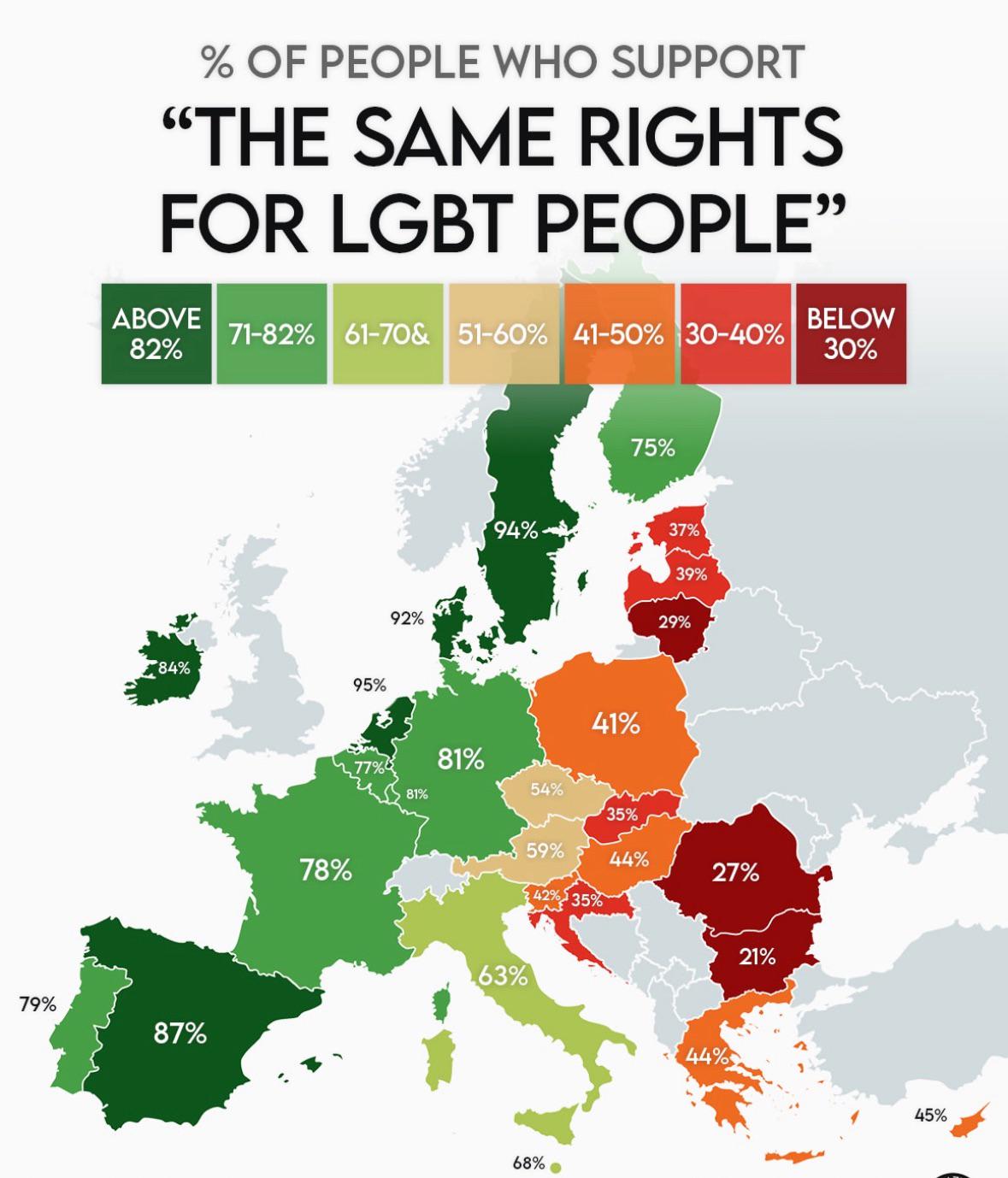Support for LGBT People in the EU Map


Marcus Rodriguez
Historical Geography Expert
Marcus Rodriguez specializes in historical cartography and geographic data analysis. With a background in both history and geography, he brings unique...
Geographic Analysis
What This Map Shows
This map provides a visual representation of support for LGBT individuals across various countries in the European Union. It highlights the different levels of acceptance, legal protections, and social attitudes toward the LGBT community. The varying shades across the map indicate how supportive or hostile each nation is, offering a clear insight into the state of LGBT rights and representation in Europe today.
Deep Dive into LGBT Rights in Europe
The support for LGBT individuals in Europe has evolved significantly over the years, influenced by cultural, historical, and political factors. Countries like the Netherlands and Belgium have been at the forefront, having legalized same-sex marriage as early as the early 2000s. Interestingly, public opinion in these nations tends to be strongly supportive of LGBT rights, reflecting decades of advocacy and societal change.
On the other hand, Eastern European countries, such as Hungary and Poland, reveal a stark contrast. These nations have seen a rise in anti-LGBT sentiment and have implemented laws that restrict the rights of LGBT individuals. In Poland, for instance, several regions have declared themselves "LGBT-free zones," leading to significant international backlash and concerns about human rights violations.
Statistics show that acceptance rates among the general population vary widely. According to a 2020 Eurobarometer survey, approximately 70% of respondents in Western Europe expressed support for LGBT rights, compared to about 30% in some Eastern European countries. This disparity highlights the ongoing challenges faced by the LGBT community, particularly in regions where traditional values still hold sway.
Moreover, the map illustrates how legal frameworks, such as anti-discrimination laws and adoption rights, play a crucial role in shaping the experience of LGBT individuals. Countries with comprehensive anti-discrimination laws tend to have higher levels of reported well-being among LGBT citizens. Conversely, in nations lacking such protections, reports of discrimination and violence against LGBT individuals remain alarmingly high.
Regional Analysis
When analyzing the map regionally, it’s fascinating to observe the differences. Western Europe, including countries like Sweden, Denmark, and Spain, showcases a high level of support for LGBT rights, characterized by inclusive legislation and vibrant LGBT communities. For example, Spain's annual Pride celebrations attract millions, symbolizing not only acceptance but also the cultural integration of LGBT identities.
In contrast, as you move towards Eastern Europe, the map reveals a concerning trend. Countries such as Bulgaria and Romania, while having made strides in recent years, still struggle with societal prejudices. In these nations, the LGBT community often faces significant hurdles, from limited legal protections to social stigma. Interestingly, Romania's Constitutional Court has ruled several times on LGBT rights issues, showcasing a complex legal landscape that continues to evolve.
Central Europe presents a mixed picture. Countries like Germany and Austria have progressive laws, but the rise of right-wing populism has sparked debates about the future of LGBT rights. Interestingly, Germany's recent legislation to allow same-sex marriage, passed in 2017, marked a significant progression, yet societal acceptance is still a work in progress.
Significance and Impact
Understanding the support for LGBT individuals in the EU matters not only for human rights advocacy but also for the overall social fabric of these nations. Discrimination against any group can have profound effects on societal health, economics, and international relations. Nations that embrace diversity and inclusivity often experience greater social cohesion and economic prosperity.
Moreover, the current trends indicate a growing momentum for change. Activism across Europe is on the rise, with young people increasingly championing LGBT rights. The intersection of technology and advocacy has also played a pivotal role, making it easier for movements to gain visibility and support. However, as seen in Hungary and Poland, there is also a backlash that cannot be ignored. The dynamics of support and opposition will likely shape the future landscape of LGBT rights in Europe, making it a critical area to watch.
Ultimately, the map of support for LGBT people in the EU is not just a reflection of laws and policies; it is a snapshot of the ongoing struggle for equality, acceptance, and human dignity in a diverse continent. Have you noticed how the conversation around LGBT rights continues to evolve, and what implications that might have for future generations? The journey towards equality is ongoing, and understanding these geographical nuances is essential in fostering a more inclusive society.
Visualization Details
- Published
- August 12, 2025
- Views
- 112
Comments
Loading comments...